warning light Hyundai Getz 2004 Workshop Manual
[x] Cancel search | Manufacturer: HYUNDAI, Model Year: 2004, Model line: Getz, Model: Hyundai Getz 2004Pages: 445, PDF Size: 12.16 MB
Page 306 of 445
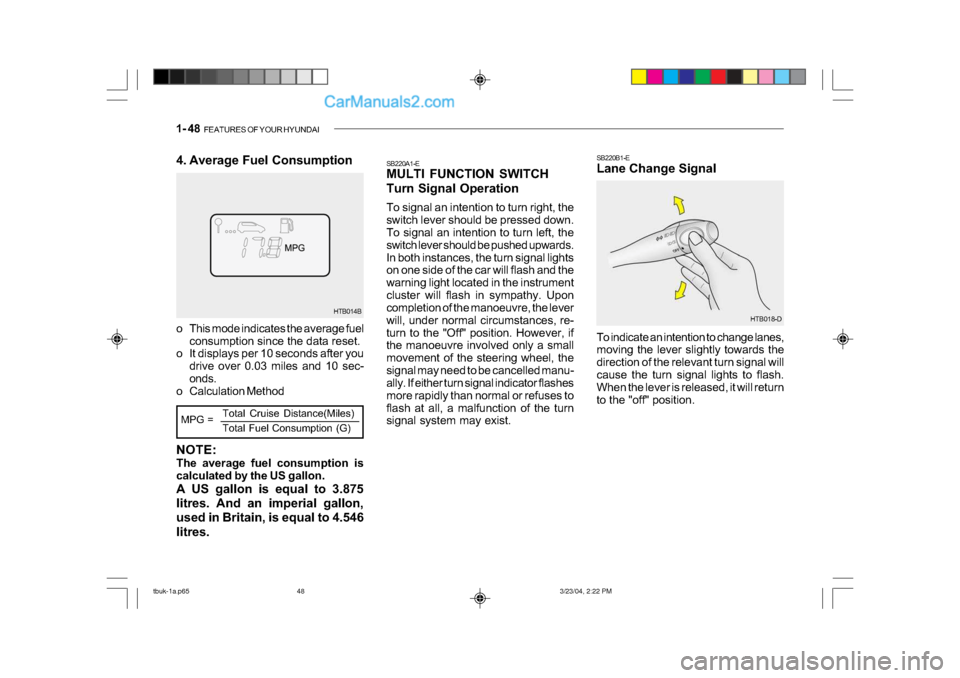
1- 48 FEATURES OF YOUR HYUNDAI
HTB014B
MPG = Total Cruise Distance(Miles)
Total Fuel Consumption (G)
4. Average Fuel Consumption
o This mode indicates the average fuel
consumption since the data reset.
o It displays per 10 seconds after you
drive over 0.03 miles and 10 sec-
onds.
o Calculation Method SB220A1-E
MULTI FUNCTION SWITCH
Turn Signal Operation
To signal an intention to turn right, the
switch lever should be pressed down.
To signal an intention to turn left, the
switch lever should be pushed upwards.
In both instances, the turn signal lights
on one side of the car will flash and the
warning light located in the instrument
cluster will flash in sympathy. Upon
completion of the manoeuvre, the lever
will, under normal circumstances, re-
turn to the "Off" position. However, if
the manoeuvre involved only a small
movement of the steering wheel, the
signal may need to be cancelled manu-
ally. If either turn signal indicator flashes
more rapidly than normal or refuses to
flash at all, a malfunction of the turn
signal system may exist. SB220B1-E
Lane Change Signal
To indicate an intention to change lanes,
moving the lever slightly towards the
direction of the relevant turn signal will
cause the turn signal lights to flash.
When the lever is released, it will return
to the "off" position.
HTB018-D
NOTE:
The average fuel consumption is
calculated by the US gallon.
A US gallon is equal to 3.875
litres. And an imperial gallon,
used in Britain, is equal to 4.546
litres.
tbuk-1a.p65 3/23/04, 2:22 PM
48
Page 309 of 445
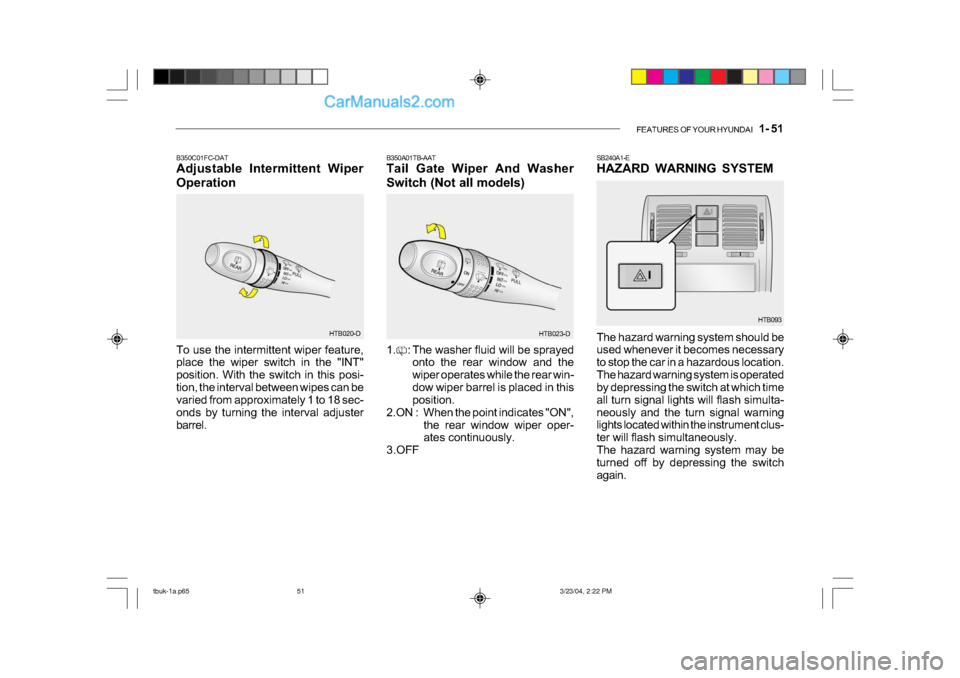
FEATURES OF YOUR HYUNDAI 1- 51
SB240A1-E
HAZARD WARNING SYSTEM
The hazard warning system should be
used whenever it becomes necessary
to stop the car in a hazardous location.
The hazard warning system is operated
by depressing the switch at which time
all turn signal lights will flash simulta-
neously and the turn signal warning
lights located within the instrument clus-
ter will flash simultaneously.
The hazard warning system may be
turned off by depressing the switch
again. HTB093B350A01TB-AAT
Tail Gate Wiper And Washer
Switch (Not all models)
HTB023-D
1. : The washer fluid will be sprayed onto the rear window and the
wiper operates while the rear win-
dow wiper barrel is placed in this
position.
2.ON : When the point indicates "ON", the rear window wiper oper-
ates continuously.
3.OFF
B350C01FC-DAT
Adjustable Intermittent Wiper
Operation
To use the intermittent wiper feature,
place the wiper switch in the "INT"
position. With the switch in this posi-
tion, the interval between wipes can be
varied from approximately 1 to 18 sec-
onds by turning the interval adjuster
barrel.
HTB020-D
tbuk-1a.p65
3/23/04, 2:22 PM
51
Page 313 of 445

FEATURES OF YOUR HYUNDAI 1- 55
!
B460A01Y-AAT
SUNROOF (Not all models)
Sun Shade
Your HYUNDAI is equipped with a
sliding sunshade which you can manu-
ally adjust to let in light with the sunroof
closed, or to block sunlight.
Loading condition Switch
position
Driver only
Driver + front passenger
Full passengers
(including driver)
Full passengers
(including driver) + full trunk
loading (or light trailer loading)
Driver + full trunk loading
(or maximum trailer loading) 0
1
2
3 0
B470A01FC
WARNING:
Never adjust the sunshade while
driving.
B340G01S-EAT
HEADLIGHT LEVELING DEVICE
SYSTEM
To adjust the headlight beam level ac-
cording to the number of the passen-
gers and the loading weight in the lug-
gage area, turn the beam leveling switch.
The higher the number of the switch
position, the lower the headlight beam
level. Always keep the headlight beam
at the proper leveling position, or head-
lights may dazzle other road users.
Listed below are the examples of rec-
ommended switch settings. For loading
conditions other than those listed be-
low, adjust the switch position so that
the beam level may be the nearest as
the condition obtained according to the
list.
HTB181-D
tbuk-1a.p65
3/23/04, 2:22 PM
55
Page 319 of 445
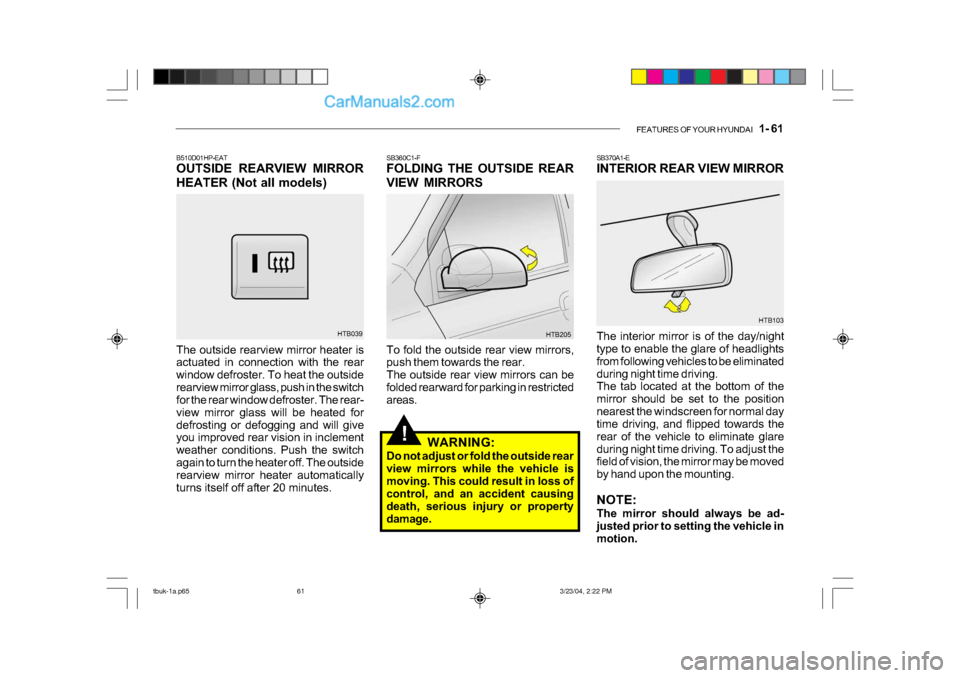
FEATURES OF YOUR HYUNDAI 1- 61
!
SB370A1-E
INTERIOR REAR VIEW MIRROR
The interior mirror is of the day/night
type to enable the glare of headlights
from following vehicles to be eliminated
during night time driving.
The tab located at the bottom of the
mirror should be set to the position
nearest the windscreen for normal day
time driving, and flipped towards the
rear of the vehicle to eliminate glare
during night time driving. To adjust the
field of vision, the mirror may be moved
by hand upon the mounting.
NOTE:
The mirror should always be ad-
justed prior to setting the vehicle in
motion. HTB103B510D01HP-EAT
OUTSIDE REARVIEW MIRROR
HEATER (Not all models)
The outside rearview mirror heater is
actuated in connection with the rear
window defroster. To heat the outside
rearview mirror glass, push in the switch
for the rear window defroster. The rear-
view mirror glass will be heated for
defrosting or defogging and will give
you improved rear vision in inclement
weather conditions. Push the switch
again to turn the heater off. The outside
rearview mirror heater automatically
turns itself off after 20 minutes. SB360C1-F
FOLDING THE OUTSIDE REAR
VIEW MIRRORS
To fold the outside rear view mirrors,
push them towards the rear.
The outside rear view mirrors can be
folded rearward for parking in restricted
areas.
HTB039
HTB205
WARNING:
Do not adjust or fold the outside rear
view mirrors while the vehicle is
moving. This could result in loss of
control, and an accident causing
death, serious injury or property
damage.
tbuk-1a.p65 3/23/04, 2:22 PM
61
Page 320 of 445
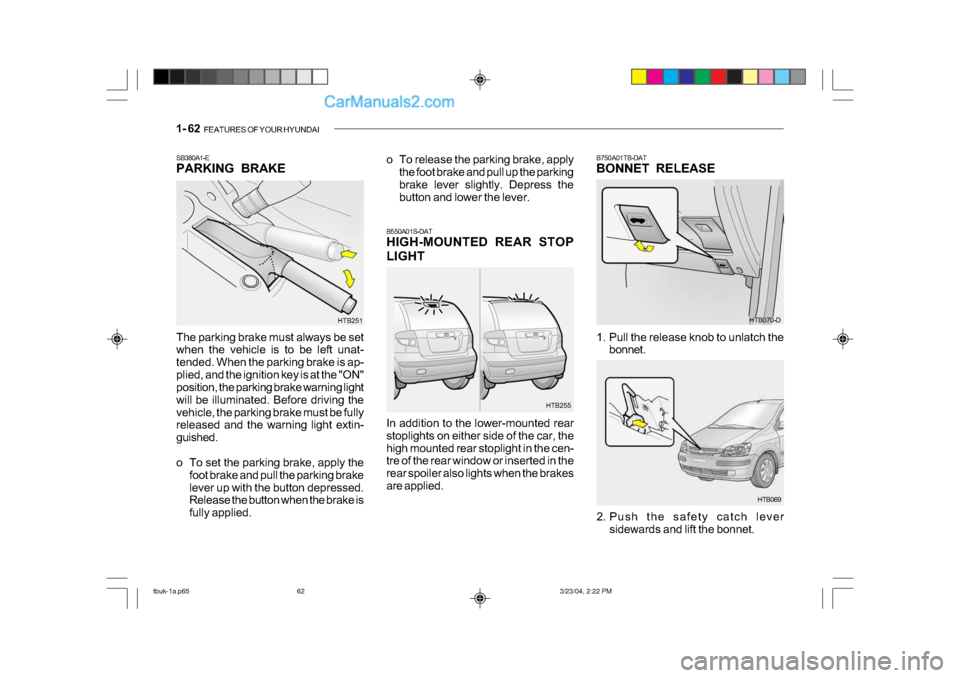
1- 62 FEATURES OF YOUR HYUNDAI
The parking brake must always be set
when the vehicle is to be left unat-
tended. When the parking brake is ap-
plied, and the ignition key is at the "ON"
position, the parking brake warning light
will be illuminated. Before driving the
vehicle, the parking brake must be fully
released and the warning light extin-
guished.
o To set the parking brake, apply the
foot brake and pull the parking brake
lever up with the button depressed.
Release the button when the brake is
fully applied.
SB380A1-E
PARKING BRAKE
B550A01S-DAT
HIGH-MOUNTED REAR STOP
LIGHT
In addition to the lower-mounted rear
stoplights on either side of the car, the
high mounted rear stoplight in the cen-
tre of the rear window or inserted in the
rear spoiler also lights when the brakes
are applied.
HTB251
HTB255
o To release the parking brake, apply
the foot brake and pull up the parking
brake lever slightly. Depress the
button and lower the lever.
B750A01TB-DAT
BONNET RELEASE
HTB070-D
1. Pull the release knob to unlatch the bonnet.
HTB069
2. Push the safety catch lever sidewards and lift the bonnet.
tbuk-1a.p65 3/23/04, 2:22 PM
62
Page 322 of 445
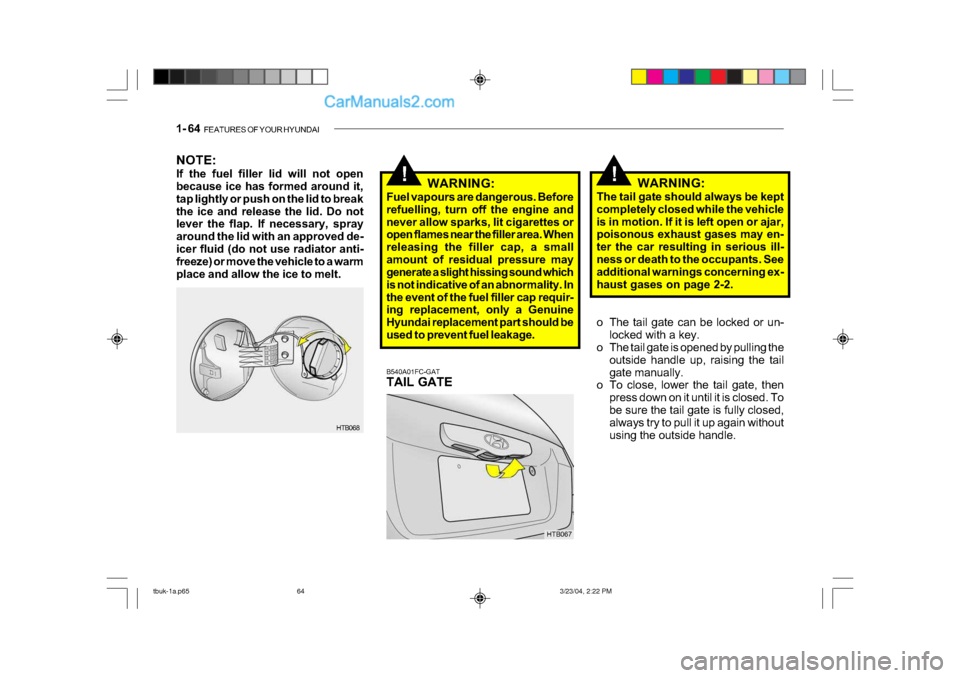
1- 64 FEATURES OF YOUR HYUNDAI
!!
NOTE:
If the fuel filler lid will not open
because ice has formed around it,
tap lightly or push on the lid to break
the ice and release the lid. Do not
lever the flap. If necessary, spray
around the lid with an approved de-
icer fluid (do not use radiator anti-
freeze) or move the vehicle to a warm
place and allow the ice to melt.
B540A01FC-GAT
TAIL GATE
HTB067WARNING:
The tail gate should always be kept
completely closed while the vehicle
is in motion. If it is left open or ajar,
poisonous exhaust gases may en-
ter the car resulting in serious ill-
ness or death to the occupants. See
additional warnings concerning ex-
haust gases on page 2-2.
HTB068 WARNING:
Fuel vapours are dangerous. Before
refuelling, turn off the engine and
never allow sparks, lit cigarettes or
open flames near the filler area. When
releasing the filler cap, a small
amount of residual pressure may
generate a slight hissing sound which
is not indicative of an abnormality. In
the event of the fuel filler cap requir-
ing replacement, only a Genuine
Hyundai replacement part should be
used to prevent fuel leakage. o The tail gate can be locked or un-
locked with a key.
o The tail gate is opened by pulling the
outside handle up, raising the tail
gate manually.
o To close, lower the tail gate, then
press down on it until it is closed. To
be sure the tail gate is fully closed,
always try to pull it up again without
using the outside handle.
tbuk-1a.p65 3/23/04, 2:22 PM
64
Page 346 of 445
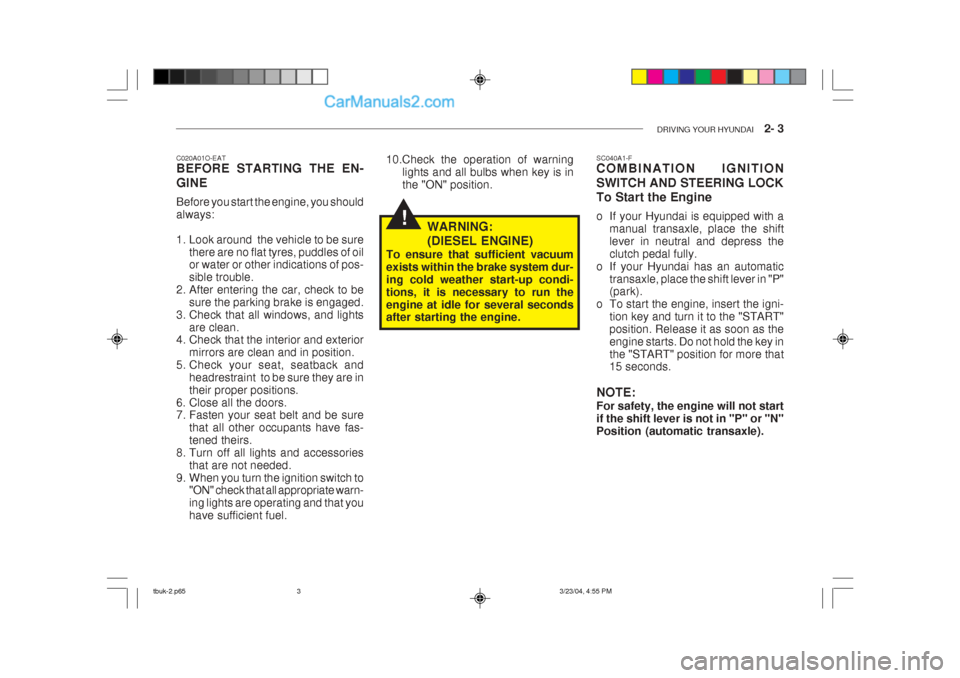
DRIVING YOUR HYUNDAI 2- 3
!
C020A01O-EAT BEFORE STARTING THE EN- GINE Before you start the engine, you should always:
1. Look around the vehicle to be sure
there are no flat tyres, puddles of oil or water or other indications of pos- sible trouble.
2. After entering the car, check to be
sure the parking brake is engaged.
3. Check that all windows, and lights are clean.
4. Check that the interior and exterior
mirrors are clean and in position.
5. Check your seat, seatback and
headrestraint to be sure they are intheir proper positions.
6. Close all the doors.
7. Fasten your seat belt and be sure
that all other occupants have fas- tened theirs.
8. Turn off all lights and accessories that are not needed.
9. When you turn the ignition switch to "ON" check that all appropriate warn-ing lights are operating and that youhave sufficient fuel. 10.Check the operation of warning
lights and all bulbs when key is inthe "ON" position.
WARNING: (DIESEL ENGINE)
To ensure that sufficient vacuum exists within the brake system dur-ing cold weather start-up condi-tions, it is necessary to run theengine at idle for several seconds after starting the engine. SC040A1-F COMBINATION IGNITION SWITCH AND STEERING LOCK To Start the Engine
o If your Hyundai is equipped with a
manual transaxle, place the shift lever in neutral and depress theclutch pedal fully.
o If your Hyundai has an automatic
transaxle, place the shift lever in "P" (park).
o To start the engine, insert the igni-
tion key and turn it to the "START" position. Release it as soon as theengine starts. Do not hold the key inthe "START" position for more that 15 seconds.
NOTE: For safety, the engine will not start if the shift lever is not in "P" or "N"Position (automatic transaxle).
tbuk-2.p65 3/23/04, 4:55 PM
3
Page 347 of 445
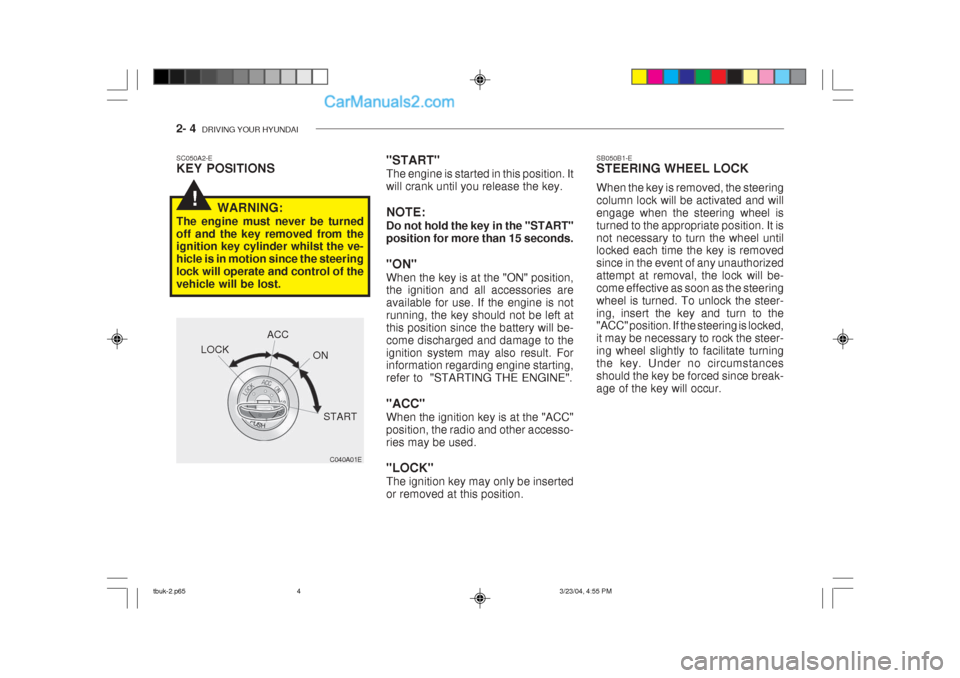
2- 4 DRIVING YOUR HYUNDAI
!
"START" The engine is started in this position. It will crank until you release the key. NOTE: Do not hold the key in the "START" position for more than 15 seconds. "ON" When the key is at the "ON" position, the ignition and all accessories are available for use. If the engine is notrunning, the key should not be left atthis position since the battery will be-come discharged and damage to theignition system may also result. For information regarding engine starting, refer to "STARTING THE ENGINE". "ACC" When the ignition key is at the "ACC" position, the radio and other accesso-ries may be used. "LOCK" The ignition key may only be inserted or removed at this position.SC050A2-E KEY POSITIONS
C040A01E
LOCK
ACC
ON
START
WARNING:
The engine must never be turned off and the key removed from the ignition key cylinder whilst the ve- hicle is in motion since the steeringlock will operate and control of thevehicle will be lost. SB050B1-E STEERING WHEEL LOCK When the key is removed, the steering column lock will be activated and willengage when the steering wheel isturned to the appropriate position. It isnot necessary to turn the wheel until locked each time the key is removed since in the event of any unauthorizedattempt at removal, the lock will be-come effective as soon as the steeringwheel is turned. To unlock the steer-ing, insert the key and turn to the "ACC" position. If the steering is locked, it may be necessary to rock the steer-ing wheel slightly to facilitate turningthe key. Under no circumstancesshould the key be forced since break-age of the key will occur.
tbuk-2.p65
3/23/04, 4:55 PM
4
Page 355 of 445
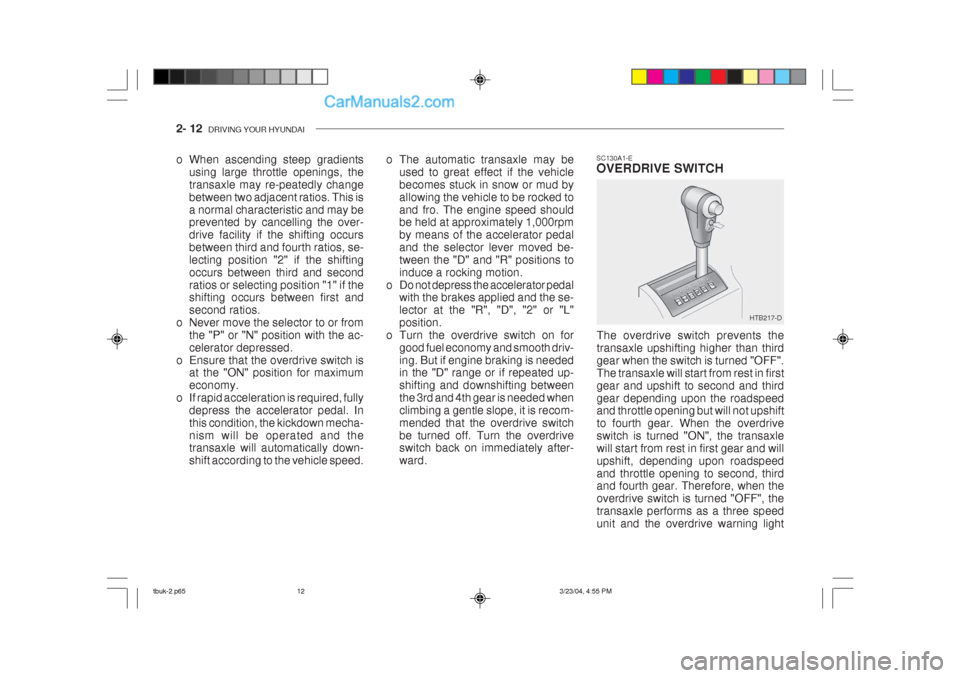
2- 12 DRIVING YOUR HYUNDAI
HTB217-D
SC130A1-E OVERDRIVE SWITCH
The overdrive switch prevents the transaxle upshifting higher than thirdgear when the switch is turned "OFF".The transaxle will start from rest in firstgear and upshift to second and thirdgear depending upon the roadspeed and throttle opening but will not upshift to fourth gear. When the overdriveswitch is turned "ON", the transaxlewill start from rest in first gear and willupshift, depending upon roadspeedand throttle opening to second, third and fourth gear. Therefore, when the overdrive switch is turned "OFF", thetransaxle performs as a three speedunit and the overdrive warning light
o When ascending steep gradients
using large throttle openings, thetransaxle may re-peatedly changebetween two adjacent ratios. This isa normal characteristic and may be prevented by cancelling the over- drive facility if the shifting occursbetween third and fourth ratios, se-lecting position "2" if the shiftingoccurs between third and secondratios or selecting position "1" if the shifting occurs between first and second ratios.
o Never move the selector to or from
the "P" or "N" position with the ac-celerator depressed.
o Ensure that the overdrive switch is at the "ON" position for maximumeconomy.
o If rapid acceleration is required, fully
depress the accelerator pedal. Inthis condition, the kickdown mecha-nism will be operated and the transaxle will automatically down- shift according to the vehicle speed. o The automatic transaxle may be
used to great effect if the vehiclebecomes stuck in snow or mud byallowing the vehicle to be rocked toand fro. The engine speed should be held at approximately 1,000rpm by means of the accelerator pedaland the selector lever moved be-tween the "D" and "R" positions toinduce a rocking motion.
o Do not depress the accelerator pedal with the brakes applied and the se-lector at the "R", "D", "2" or "L"position.
o Turn the overdrive switch on for good fuel economy and smooth driv-ing. But if engine braking is needed in the "D" range or if repeated up- shifting and downshifting betweenthe 3rd and 4th gear is needed whenclimbing a gentle slope, it is recom-mended that the overdrive switchbe turned off. Turn the overdrive switch back on immediately after- ward.
tbuk-2.p65 3/23/04, 4:55 PM
12
Page 357 of 445
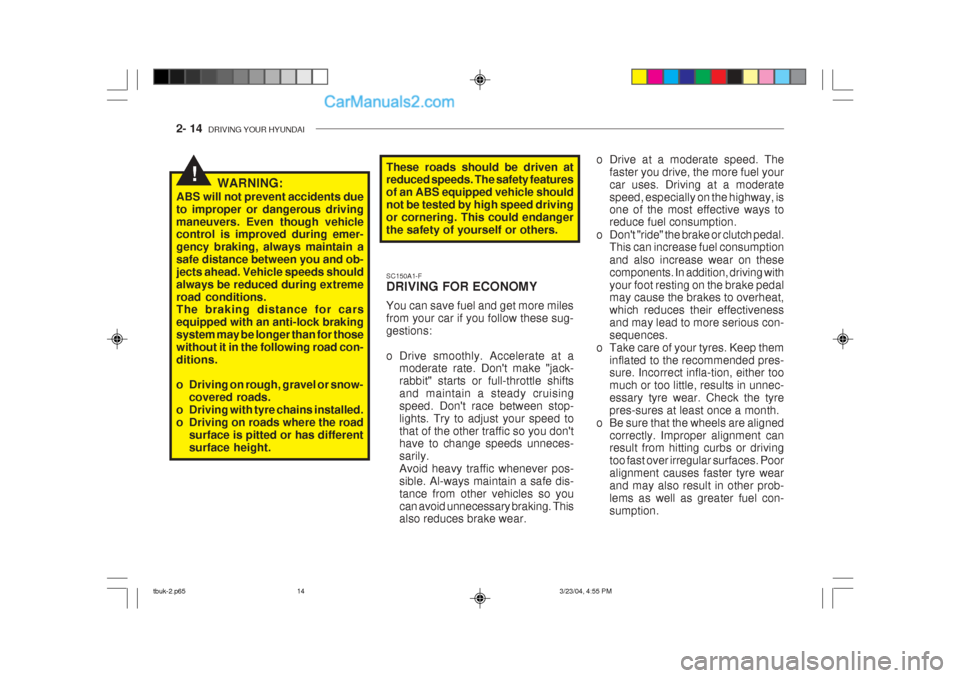
2- 14 DRIVING YOUR HYUNDAI
!WARNING:
ABS will not prevent accidents due to improper or dangerous drivingmaneuvers. Even though vehicle control is improved during emer- gency braking, always maintain asafe distance between you and ob-jects ahead. Vehicle speeds shouldalways be reduced during extremeroad conditions. The braking distance for cars equipped with an anti-lock brakingsystem may be longer than for thosewithout it in the following road con-ditions.
o Driving on rough, gravel or snow- covered roads.
o Driving with tyre chains installed.
o Driving on roads where the road
surface is pitted or has differentsurface height. These roads should be driven at reduced speeds. The safety features of an ABS equipped vehicle shouldnot be tested by high speed drivingor cornering. This could endangerthe safety of yourself or others. SC150A1-F DRIVING FOR ECONOMY You can save fuel and get more miles from your car if you follow these sug-gestions:
o Drive smoothly. Accelerate at a
moderate rate. Don't make "jack- rabbit" starts or full-throttle shiftsand maintain a steady cruisingspeed. Don't race between stop-lights. Try to adjust your speed tothat of the other traffic so you don't have to change speeds unneces- sarily.Avoid heavy traffic whenever pos-sible. Al-ways maintain a safe dis-tance from other vehicles so youcan avoid unnecessary braking. This also reduces brake wear. o Drive at a moderate speed. The
faster you drive, the more fuel your car uses. Driving at a moderatespeed, especially on the highway, isone of the most effective ways to reduce fuel consumption.
o Don't "ride" the brake or clutch pedal. This can increase fuel consumption and also increase wear on thesecomponents. In addition, driving withyour foot resting on the brake pedal may cause the brakes to overheat, which reduces their effectivenessand may lead to more serious con-sequences.
o Take care of your tyres. Keep them inflated to the recommended pres- sure. Incorrect infla-tion, either too much or too little, results in unnec-essary tyre wear. Check the tyrepres-sures at least once a month.
o Be sure that the wheels are aligned correctly. Improper alignment can result from hitting curbs or driving too fast over irregular surfaces. Pooralignment causes faster tyre wearand may also result in other prob-lems as well as greater fuel con-sumption.
tbuk-2.p65 3/23/04, 4:55 PM
14